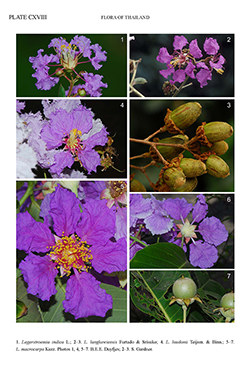e-Flora of Thailand
Volume 11 > Part 4 > Year 2014 > Page 569 > Lythraceae > Lagerstroemia
9. Lagerstroemia loudonii Teijsm. & Binn.wfo-0000366803
Natuurk. Tijdschr. Ned.-Indië 25: 425. 1863 (‘loudoni’); Gagnep., Fl. Indo-Chine [P.H.Lecomte et al.] 2: 954. 1921; Craib, Fl. Siam. 1: 724. 1931; Furtado & Srisuko, Gard. Bull. Singapore 24: 303, f. 43. 1969; P.H.Hô, Ill. Fl. Vietnam 2(1): 27, f. 3669. 1992; S.Gardner, Sidisunthorn & Anusarnsunthorn, Field Guide Forest Trees Northern Thailand: 202: 441. 2000; W.J.de Wilde & Duyfjes, Thai Forest Bull., Bot. 41: 98. 2013.— L. tomentosa var. loudonii (Teijsm. & Binn.) C.B.Clarke, Fl. Brit. India [J.D.Hooker] 2: 578. 1879. Plate CXVIII: 4.
Accepted Name : This is currently accepted.
Synonyms & Citations :
Description : Trees 4–10 m tall; bark light brown, thin, vertically cracked and flaking (salao). Leaves: petiole ca 0.5 cm long; lamina shortly soft-hairy beneath, 4–20 cm long; lateral veins 8–13 on each side; intercostal venation scalariform. Inflorescences lateral (axillary), lax, 10–18(–25) cm long. Flowers: bud stellate-dendroid hairy, obovoid, 5–9 mm long, pseudopedicel 2(–7) mm long; calyx tube 3–4 mm long, nearly without ridges or faintly 12-ridged, without auricles; calyx lobes 6 (or 7), hairy in upper half within, 3–4 mm long; petals (dark) purple, turning white with age, blade ovate or obovate, 15–20 mm long, margin irregularly serrate-fimbriate, especially so in upper half, claw ca 7 mm long; stamens asymmetrically dimorphic (outer 6 or 7 stamens longer than inner ones and directed towards a gap between the petals); ovary hairy. Capsules black, glossy, smooth, coarsely reticulate when dry (not shagreen), often hairy at apex, globose or broadly ellipsoid, (10–)12–18 mm long, 5- or 6-valved; fruiting calyx without distinct ridges; calyx lobes thin, hairy or with remnants of hairs within, reflexed; fruiting pseudopedicel 2–4(–7) mm long.
Thailand : EASTERN: Nakhon Ratchasima (Ban Chum Saeng, Sakae Rat Pak Thong Chai); SOUTH-WESTERN: Kanchanaburi, Prachuap Khiri Khan (Khao Sam Roi Yot NP, Hua Hin, Khao Chrongwan, Boekit Petjaboerie – type of Lagerstroemia loudonii: Teijsmann 5938, holotype -U); CENTRAL: Chai Nat, Lop Buri (Khao Samo Khon), Saraburi (Phu Khae, Hin Lap); SOUTH-EASTERN: Chon Buri, Chanthaburi (Khao Soi Dao, HQ Thung Pra, Khao Sip Ha Chan, Kaeng Hang Maeo, Wang Kaphae, Pong Nam Ron).
Distribution : Cambodia, Laos, Vietnam, cultivated elsewhere. Most collections are from doubtfully wild localities.
Ecology : In evergreen forests, thickets, and shrub forests; granite and limestone bedrock; 20–350 m alt. Flowering: February–June; fruiting: February–September.
Vernacular : Kriap (เกรียบ), ta-kraip (ตะเกรียบ)(Chong- Chanthaburi); tabaek khon (ตะแบกขน)(Nakhon Ratchasima); salao (เสลา)(Nakhon Ratchasima); salao bai yai (เสลาใบใหญ่)(Prachuap Khiri Khan, Saraburi); inthara chit (อินทรชิต)(Prachin Buri).
CommonName : Thai bungor
Uses: Ornamental tree, commonly planted along roads.
Notes: Lagerstroemia loudonii is characterised by lateral (axillary) inflorescences, fringed petal margins, black fruits, and scalariform leaf venation; in the field the species can be recognised by its drooping branches.
The longer filaments are purple with blackish anthers, the shorter ones are pale yellow with yellow anthers.

